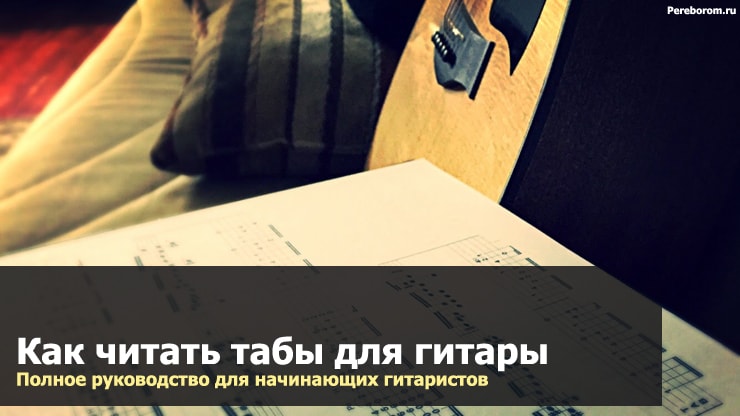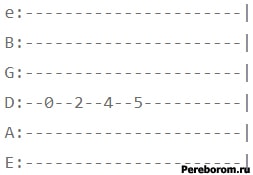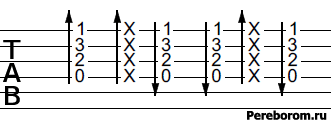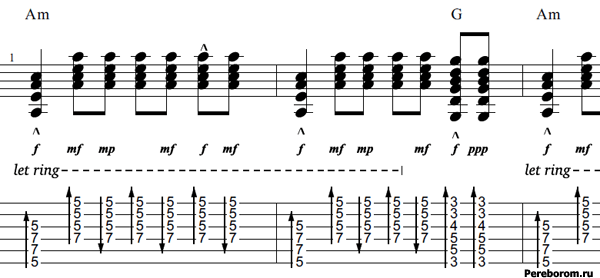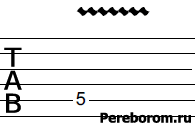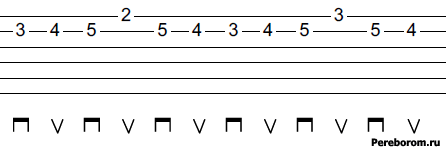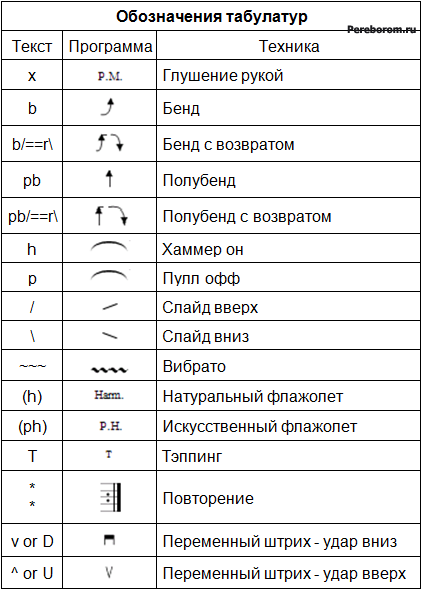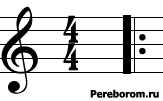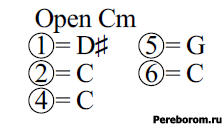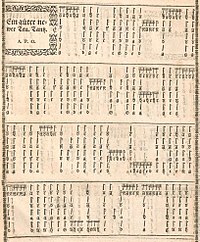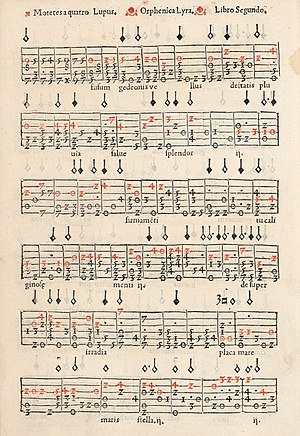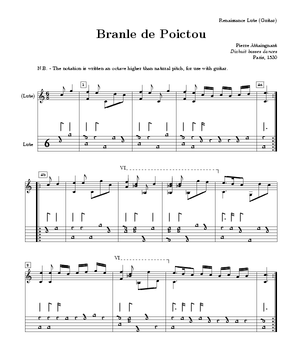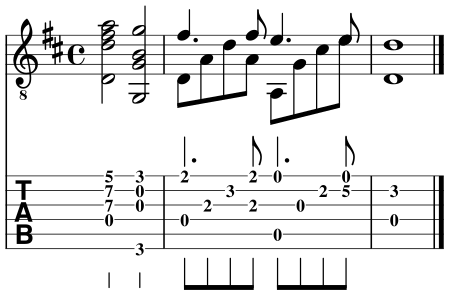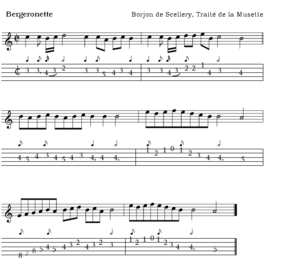Содержание статьи
- 1
- 2 Что такое табулатура для гитары
- 3 Виды табулатур
- 3.1 Интернет запись
- 3.2 Запись через редактор табулатур
- 4 Как пользоваться табами новичку
- 4.1 Обозначение боя
- 4.2 Перебор или арпеджио
- 4.3 Обозначение аккордов
- 4.4 Мелодия
- 5 Как читать табы обозначения и знаки
- 5.1 Хаммер-он (Hammer On)
- 5.2 Пулл-офф (Pull Off)
- 5.3 Бенд -подтяжка (Bend)
- 5.4 Слайд (Slide)
- 5.5 Вибрато (Vibrato )
- 5.6 Let Ring
- 5.7 Глушение струны правой рукой (Palm Mute)
- 5.8 Не звучащие или мертвые ноты (Mute)
- 5.9 Нота призрак (Ghost Note)
- 5.10 Переменный штрих — удары вниз и вверх (Downstrokes & Upstrokes)
- 5.11 Натуральный флажолет (Natural Harmonics)
- 5.12 Каподастр (Capo)
- 5.13 Тэппинг (Tapping)
- 6 Общая таблица символов используемых в текстовых и нотных табах
- 7 Обозначения ритма, размера и строя в табулатуре
- 7.1 Размер
- 7.2 Темп
- 7.3 Нумерация тактов
- 7.4 Строй гитары
- 8 Программа для табулатур
- 9 Советы и рекомендации
Что такое табулатура для гитары
Раньше песни записывались при помощи нот и нотных листов. Это было очень удобно, поскольку позволяло разложить и сыграть партии, не базируясь на особенностях инструментов, а также вносило единство игры оркестра на концертах. С появлением гитары ситуация не поменялась до тех пор, пока люди не поняли некоторое неудобство этой системы. В гитаре одни и те же ноты можно взять на совершенно разных ладах и в разных позициях, и, поскольку ноты не обозначают этого, то манера игры некоторых произведений становилась менее очевидной. Ситуацию исправил другой способ записи – табулатуры, который плотно вошел в обиход гитариста. Сколько нужно играть на гитаре для того, чтобы использовать табы? Чем раньше вы начнете это делать – тем лучше.
Они представляют собой тот же самый нотный стан, только с шестью, по количеству струн, линий. На них вместо нот записаны гитарные лады, на которых следует зажимать обозначенные струны для получения нужного звука. Такой метод записи оказался намного удобнее, и поэтому сейчас каждый гитарист должен понять, как читать табулатуру для удобства разучивания произведений. Именно этому и посвящена данная статья. Это действительно стоит знать даже тем, кто учился в музыкальной школе – ведь то, как мы читаем табулатуры для гитары сильно различается с тем, как распознавать ноты.
Виды табулатур
Интернет запись
Такой способ распространен на сайтах, где нет возможности записывать табы в специальных программах. В этом случае внешний вид полностью копируется и суть практически не меняется, за исключением способа обозначения приемов игры.
Запись через редактор табулатур
Самый популярный способ. В этом случае данный вид записи воспроизводит программа, которая при помощи специальных пресетов имитирует звуки гитары, включая различные приемы игры. Это гораздо удобнее, ведь помимо непосредственно цифр, в них, как правило, есть еще и ноты с их длительностями, что еще больше упрощает разучивание песни.
Смотрите видео урок №34 из курса «Начинающий»: Что такое табулатуры и как их читать?
Как пользоваться табами новичку
Обозначение боя
Обычно в табах гитарный бой обозначается стрелками напротив каждого отдельного аккорда, или их групп. Обратите внимание на то, что они показывают движение с реверсом – то есть стрелка вниз обозначает удар вверх, а вверх – удар вниз. Тот же принцип работает и со струнами – то есть верхняя линия будет первой, а нижняя – шестой.
Перебор или арпеджио
Переборы на гитаре обычно визуально видно сразу – вы можете понять, какую струну и когда дергать, какой лад зажимать, и какие приемы использовать. В случае с арпеджио номера ладов будут выстроены синусоидами – то есть дугами вверх-вниз. Заранее просматривайте весь такт, поскольку обычно зажав все участвующие струны вы получите нужный аккорд. Разумеется, это не относится к свип-соло, которые требуют иную постановку рук.
Обозначение аккордов
Обычно над группой цифр, которые обозначают лады, пишутся также и аккорды, которыми эти группы и являются. Они находятся прямо над ними – далеко искать не надо.
Мелодия
Всю мелодию можно проследить внутри табов. В программе каждому инструменту отведена своя дорожка, благодаря чему вы легко сможете выучить нужную вам партию.
Как читать табы обозначения и знаки
Хаммер-он (Hammer On)
На письменной табе он обозначается как буква «h» между двумя цифрами. Первая – номер лада, который вам требуется зажать, вторая – тот, на который надо положить палец для данного действия. Например, 5h7.
В программе это действие контекстуально и обозначается дугой под двумя цифрами. Если первая меньше второй – то это хаммер.
Прослушать фрагмент:
Пулл-офф (Pull Off)
В письме этот прием пишется как буква «p» между также двумя цифрами. Первая – то, что вы зажимаете изначально, а вторая – то, какой лад играется после. Например, 6p4 – то есть вы должны сыграть сначала ноту на шестом ладу, а потом произвести пул-офф, зажав при этом четвертый.
В программе он обозначается так же, как и хаммер – дугой под ладами, однако первая цифра будет больше второй.
Прослушать фрагмент:
Бенд -подтяжка (Bend)
На письме он обозначается как буква b после номера лада. Проблема в том, что существует несколько видов бэндов, и чтобы понять, какой используется сейчас, придется вслушиваться в композицию. Кроме того, иногда придется возвращаться в исходную позицию – и тогда писаться будет так – 4b6r4, то есть, буквой r.
В программе все намного проще – там от лада будет прорисована дуга, которая покажет полноту подтяжки, а также необходимость туда возвращаться.
Прослушать фрагмент:
Слайд (Slide)
И на письме, и в программе, он обозначается линиями или / — если это нисходящий или восходящий слайд соответственно. При этом в программе вы также услышите характерный для слайда звук.
Прослушать фрагмент:
Вибрато (Vibrato )
На письме вибрато обозначается символами Х или ~ возле номера нужного лада. В программе же изображается символом кривой линии над числовым обозначением.
Прослушать фрагмент:
Let Ring
Так пишут, когда надо дать струне или аккорду прозвучать – особенно это критично в басовых партиях фингерстайл-паттернов. В этом случае в программе над таблицей ладов будет надпись Let Ring и пунктиром будет проставлено, до какого момента это надо делать.
Прослушать фрагмент:
Глушение струны правой рукой (Palm Mute)
На письме этот прием тоже никак не обозначается. В программе же вы увидите значок PM над таблицей ладов, а также пунктирную линию, которая показывает, до какого момента аккорд играется так.
Прослушать фрагмент:
Не звучащие или мертвые ноты (Mute)
И на письме, и в программе, подобные вещи обозначаются знаком Х вместо номера лада.
Прослушать фрагмент:
Нота призрак (Ghost Note)
Эти ноты и в письме, и в программе для чтения табов, будут заключены в скобки. Играть их необязательно, но для полноты мелодики крайне желательно.
Прослушать фрагмент:
Переменный штрих — удары вниз и вверх (Downstrokes & Upstrokes)
Они обозначаются символами V или ^ для движения вниз или вверх соответственно. Такое обозначение будет прямо над группой аккордов в табулатуре.
Прослушать фрагмент:
Натуральный флажолет (Natural Harmonics)
Натуральные флажолеты, помимо того, что на письме обозначаются в скобках <>, например, <5>, еще и визуально показаны в программе – в виде более мелких по размеру нот и цифр. К слову, искусственные, обозначаются так – [].
Прослушать фрагмент:
Каподастр (Capo)
Обычно факт наличия капо пишется до начала табулатуры – в пояснениях во вступлении.
Тэппинг (Tapping)
Тэппинг и в письме, и в программе обозначается буквой T над играемым паттерном.
Прослушать фрагмент:
Общая таблица символов используемых в текстовых и нотных табах
Обозначения ритма, размера и строя в табулатуре
Размер
Размер обозначается в начале нужного такта – в виде двух чисел, которые находятся одно над другим.
Темп
Темп обозначается в самом начале нужного такта, прямо над ним в виде картинки ноты и проставленного напротив него числа, обозначающего Bpm.
Нумерация тактов
Такты также нумеруются в начале каждого нового.
Строй гитары
Строй, если он не является стандартным, также обозначается в начале всей табулатуры – и не меняется на протяжении всей песни.
Программа для табулатур
Самая удобная программа для чтения табов – это Guitar Pro версий 5.2 или 6. Кроме того, существует Tux Guitar, однако этот вариант подойдет преимущественно для пользователей Linux.
Советы и рекомендации
Совет можно, по факту, дать только один – читайте табы внимательно, и по возможности, ориентируйтесь еще и по нотам. Постоянно слушайте и вслушивайтесь – все приемы обозначены в тексте, и поэтому вам будет только легче понять, как играется данная композиция. Не стесняйтесь при необходимости менять темп отдельных кусков трека, чтобы выучить его лучше, а также понять, как исполняется тот или иной отрезок. Ну и, разумеется, не забывайте про метроном.
Поддержать проект и создание уроков можно на Cбер 2202 2004 1296 6077
Русский[править]
Морфологические и синтаксические свойства[править]
| падеж | ед. ч. | мн. ч. |
|---|---|---|
| Им. | табулату́ра | табулату́ры |
| Р. | табулату́ры | табулату́р |
| Д. | табулату́ре | табулату́рам |
| В. | табулату́ру | табулату́ры |
| Тв. | табулату́рой табулату́рою |
табулату́рами |
| Пр. | табулату́ре | табулату́рах |
та—бу—ла—ту́—ра
Существительное, неодушевлённое, женский род, 1-е склонение (тип склонения 1a по классификации А. А. Зализняка).
Встречаются также варианты написания и произношения: табулятура и устар. таблатура.
Производное: ??.
Корень: —.
Произношение[править]
- МФА: ед. ч. [təbʊɫɐˈturə], мн. ч. [təbʊɫɐˈturɨ]
Семантические свойства[править]
Значение[править]
- истор., муз. схематическая система записи инструментальной музыки, оперирующая рабочими элементами музыкального инструмента (клавишами, струнами, ладами); в настоящее время часто применяется для шестиструнной гитары ◆ Таинственная, иероглифическая табулатура немецкая была доступна очень немногим; поэтому музыкальные авторы или ревностные собиратели музыкальных достопримечательностей и редкостей могли смело доверять этому письму музыкальные произведения, не опасаясь более ни музыкальных похищений, ни слишком большого распространения этих произведений. В. В. Стасов, «Автографы музыкантов в Императорской публичной библиотеке» // «Отечественные записки», 1856 г. [Google Книги] ◆ Количество органных табулатур возрастает в последней трети XVI и в начале XVII века. М. С. Друскин, «Клавирная музыка Испании, Англии, Нидерландов, Франции, Италии, Германии XVI–XVIII веков», 1960 г. [Google Книги]
- истор., филол. система правил, регламентировавших формы и содержание музыкально-поэтического искусства мейстерзингеров ◆ Поэтическая деятельность подверглась строжайшей регламентации: правила, которым должен был следовать поэт-ремесленник, собирались в особые книги — табулатуры. Б. Ф. Кевбрин, А. А. Тарасов, «Развитие капитализма, философии и этики буржуа», 2003 г. [НКРЯ] ◆ Как сами мейстерзингеры относились к измышленным ими параграфам табулатуры становится понятным из следующего параграфа её: ..кто не в состоянии понять табулатуры, тот да будет учеником; кто знает всю её, тот может быть членом школы …; кто может, руководствуясь этими правилами, петь, тот певец; кто сам делает к напевам песни слова, тот поэт; тот же кто умеет находить и самые напевы, есть Мейстер. А. С. Рамзадзе, «Очерки истории музыки от девнейших времен до половины XIX века», 1888 г. [Google Книги]
Синонимы[править]
- табулятура; муз. жарг. (для гитары): таба
- ?
Антонимы[править]
- —
- ?
Гиперонимы[править]
- музыкальная нотация
- правила
Гипонимы[править]
- ?
- ?
Родственные слова[править]
| Ближайшее родство | |
Этимология[править]
Происходит от позднелат. tabulatura, далее от среднелат. tabula «таблица, схема», далее из лат. tabula «доска, плита»
Фразеологизмы и устойчивые сочетания[править]
Перевод[править]
| схематическая система записи инструментальной музыки, оперирующая рабочими элементами музыкального инструмента (клавишами, струнами, ладами); в настоящее время часто применяется для шестиструнной гитары | |
|
| система правил, регламентировавших формы и содержание музыкально-поэтического искусства мейстерзингеров | |
Библиография[править]
Белорусский[править]
Морфологические и синтаксические свойства[править]
табулатура
Существительное, женский род.
Корень: —.
Произношение[править]
Семантические свойства[править]
Значение[править]
- муз. табулатура ◆ Отсутствует пример употребления (см. рекомендации).
Синонимы[править]
Антонимы[править]
Гиперонимы[править]
Гипонимы[править]
Родственные слова[править]
| Ближайшее родство | |
Этимология[править]
От ??
Фразеологизмы и устойчивые сочетания[править]
|
|
Для улучшения этой статьи желательно:
|
Болгарский[править]
Морфологические и синтаксические свойства[править]
табулатура
Существительное, женский род.
Корень: —.
Произношение[править]
Семантические свойства[править]
Значение[править]
- муз. табулатура ◆ Отсутствует пример употребления (см. рекомендации).
Синонимы[править]
Антонимы[править]
Гиперонимы[править]
Гипонимы[править]
Родственные слова[править]
| Ближайшее родство | |
Этимология[править]
От ??
Фразеологизмы и устойчивые сочетания[править]
|
|
Для улучшения этой статьи желательно:
|
Украинский[править]
Морфологические и синтаксические свойства[править]
табулатура
Существительное, женский род.
Корень: —.
Произношение[править]
Семантические свойства[править]
Значение[править]
- муз. табулатура ◆ Отсутствует пример употребления (см. рекомендации).
Синонимы[править]
Антонимы[править]
Гиперонимы[править]
Гипонимы[править]
Родственные слова[править]
| Ближайшее родство | |
Этимология[править]
От ??
Фразеологизмы и устойчивые сочетания[править]
|
|
Для улучшения этой статьи желательно:
|
Табулату́ра (нем. Tabulatur, итал. intavolatura) — тип музыкальной нотации, схематическая запись музыки для клавишных (органа, клавесина), некоторых струнных (лютни, виуэлы, гитары) и (редко) духовых инструментов. Табулатура оперирует рабочими элементами музыкального инструмента (клавишами, струнами, ладами). Для сокращения записи в табулатуре применяются буквы, цифры и специальные символы.
Все значения слова «табулатура»
-
Музыканты в пудреных париках листали табулатуры и грозно взмахивали смычками.
-
Клочок бумаги с записью первой строфы, припева и краткой табулатуры был зажат в руке.
-
Если помимо стихов ты надеешься найти здесь табулатуры, то тебя ждёт разочарование… однако не спеши огорчаться: это всего лишь означает, что ни для единого из нижеприведённых текстов я не настаиваю на своей собственной версии аккомпанемента.
- (все предложения)
- фагот
- ми-бемоль
- бемоль
- мандолина
- вокализ
- (ещё синонимы…)
- Склонение
существительного «табулатура»
Example of numeric vihuela tablature from the book «Orphenica Lyra» by Miguel de Fuenllana (1554). Red numerals (original) mark the vocal part.
Tablature (or tabulature, or tab for short) is a form of musical notation indicating instrument fingering rather than musical pitches.
Tablature is common for fretted stringed instruments such as the guitar, lute or vihuela, as well as many free reed aerophones such as the harmonica. Tablature was common during the Renaissance and Baroque eras, and is commonly used today in notating many forms of music.
Three types of organ tablature were used in Europe: German, Spanish and Italian.[1]
To distinguish standard musical notation from tablature, the former is usually called «staff notation» or just «notation».
Etymology[edit]
The word tablature originates from the Latin word tabulatura. Tabula is a table or slate, in Latin. To tabulate something means to put it into a table or chart.
Origin[edit]
The first known occurrence in Europe is around 1300, and was first used for notating music for the organ.[page needed]
Concepts[edit]
While standard notation represents the rhythm and duration of each note and its pitch relative to the scale based on a twelve tone division of the octave, tablature is instead operationally based, indicating where and when a finger should be placed to generate a note, so pitch is denoted implicitly rather than explicitly. Tablature for plucked strings is based upon a diagrammatic representation of the strings and frets of the instrument, keyboard tablature represents the keys of the instrument, and woodwind tablature shows whether each of the fingerholes is to be closed or left open.
French lute tablature[edit]
French Renaissance style lute tablature, with corresponding notation for guitar (with capo on third fret or tuned up a minor third): a simple Renaissance dance, printed by Pierre Attaingnant.
F____________________ D____________________ A____________________ F____________________ D____________________ A____________________
Lowercase letters or «glyphs»are placed on each of these lines to represent notes. If it is required to play an open D course, for instance, a small a will be placed on the appropriate line. For a note with the finger on the first fret a b, a note on the second fret a c, etc. However, as mentioned above, j was not used since it was not considered a separate letter from i, and c often looked more like r or the third letter of the Greek alphabet, Γ (gamma). Thus:
F_____c___ D_____a___ A_____b___ F_____c___ D_____a___ A_____b___ G - a
would represent a G-minor chord (on a Renaissance lute in G-tuning),
All open strings would represent a D-minor chord:
F______a________ D______a________ A______a________ F______a________ D______a________ A______a________ D- ///a
The strings below the sixth course are notated with additional short ledger lines: glyphs are placed below the staff. These courses are tuned in accordance with the key of each piece played:
G- a F- /a E- //a D- ///a C- 4 B- 5 A- 6
German lute tablature[edit]
The origins of German lute tablature can be traced back well into the 15th century. Blind organist Conrad Paumann is said to have invented it.[2] It was used in German-speaking countries until the end of the 16th century.
Computer programs for writing tablatures[edit]
Various computer programs are available for writing tablature; some also write lyrics, guitar chord diagrams, chord symbols, and/or staff notation. ASCII tab files can be written (somewhat laboriously) with any ordinary word processor or text editor, using a monospaced font such as ‘Courier New’ so that characters maintain vertical alignment across all strings.
Guitar tablature[edit]
Guitar tablature is used for acoustic and electric guitar (typically with 6 strings). A modified guitar tablature with four strings is used for bass guitar. Guitar and bass tab is used in pop, rock, folk, and country music lead sheets, fake books, and songbooks, and it also appears in instructional books and websites. Tab may be given as the only notation (as with chord tab in songbooks that only include lyrics and chords), or, as with guitar solo transcriptions, tab and standard notation may be provided. Sheet music consisting of tablature is sometimes referred to as «tabs.» The same style of tablature is also used for other fretted instruments such as the banjo, mandolin, and ukulele.
The following examples are labelled with letters on the left denoting the string names, with a lowercase e for the high E string. Tab lines may be numbered 1 through 6 instead, representing standard string numbering, where «1» is the high E string, «2» is the B string, etc. Also, the order of lines is not standardized. Some tablature is written in pitch order, with the high «e» string on top, and descending in pitch order to the low «E» string on the bottom. Other tablature is written the other way, with the string closest to the ceiling (the low «E») on top and the one closest to the floor (the high «e») on the bottom. To avoid confusion, tablature writers will often write the pitches to the left of the tablature so the reader knows the convention being used.
The numbers that are written on the lines represent the fret used to obtain the desired pitch. For example, the number 3 written on the top line of the staff indicates that the player should press down at the third fret on the high E (first string). Number 0 denotes the nut — that is, an open string. If music is to be played using a capo, the numbers always indicate the number of frets from the capo, and not from the nut (thus, it is transposed into the capoed key). For chords, a letter above or below the tablature staff denotes the root note of the chord, chord notation is also usually relative to a capo, so chords played with a capo are transposed. Chords may also be notated with chord diagrams.
Examples of guitar tablature notation:
The chords E, F, and G as an ASCII tab:
e|---0---1---3---
B|---0---1---0---
G|---1---2---0---
D|---2---3---0---
A|---2---3---2---
E|---0---1---3---
E F G
Tablature can use various lines, arrows, and other symbols to denote various legato techniques, such as bends, hammer-ons, trills, pull-offs, slides, and so on. Common tablature symbols represent various techniques, though these may vary, include:
| Symbol | Technique |
|---|---|
| h | hammer on |
| p | pull off |
| b | bend string up |
| r | release bend |
| / | slide up |
| slide down | |
| v | vibrato (sometimes written as ~) |
| t | right hand tap |
| s | legato slide |
| S | shift slide |
| * | natural harmonic |
| [n] | artificial harmonic |
| n(n) | tapped harmonic |
| tr | trill |
| T | tap |
| TP | tremolo picking |
| PM | palm muting (also written as _ and .) |
| N.C. | No chord: tacet or rest |
| n/ | tremolo arm dip; n = amount to dip |
| n | tremolo arm down |
| n/ | tremolo arm up |
| /n | tremolo arm inverted dip |
| = | hold bend; also acts as connecting device for hammers/pulls |
| <> | volume swell (louder/softer) |
| x | on rhythm slash represents muted slash |
| o | on rhythm slash represents single note slash |
| ·/. | pick slide |
Further symbols to indicate note lengths may be used along the top of the tablature, examples include:[3]
| Symbol | Note Length |
|---|---|
| W | Whole note/semibreve |
| H | Half note/minim |
| Q | Quarter note/crotchet |
| E | Eighth note/quaver |
| a | Acciaccatura |
| — | Note tied to previous |
| . | Note dotted |
Guitar tablature is not standardized and different sheet-music publishers adopt different conventions. Songbooks and guitar magazines usually include a legend setting out the convention in use.
The most common form of lute tablature uses the same concept but differs in the details (e.g., it uses letters rather than numbers for frets). See above.
When circles are used to indicate fingering, sounded notes are white, an assumed root is grey, and a sounded root is black.[4][5]
Musette tablature[edit]
Musette tablature from Borjon de Scellery
The standard notation shown in the illustration is also taken from de Scellery; no explanation is given for the slur-like symbol; the comma (,) is explained as indicating a tremblement, starting on the note above. No explanation is given for the unusual beaming or the significance (if any) of where note-length symbols are repeated.
Harmonica tablature[edit]
For example, on a «C» diatonic instrument:
Unbent Bent lv1 Bent lv2 Bent lv3 3i (B) 3i| (Bb) 3i|| (A) 3i||| (G#)
To indicate button-press on a chromatic instrument, a similar indication to first-level bending may be used.
The breath indicator may be placed right next to the hole number, or below the number. The same is true for bending or button-press indicators.
To indicate the beat, in the arrow system the length of the arrow may be varied. However, the more popular method is to use a slightly simplified rhythm-symbol notation, such as «o» for a semibreve, // for a minim, «/» for a crotchet, «.» for quavers, and place them above the characters, while spacing them accordingly.
For chords, the numbers to play are shown, so, for example:
a C major (CEG) chord (on a C diatonic instrument): 456e
However, they may simplify it, especially when playing blues. For chords, it was common to just play three or two holes instead (sometimes even just one), especially when the instrument is not of the same key. For example, in the blues progression in G (G G G G7 C C G G D7 D7 G G) it is common to use a C diatonic instrument, and notate the following:
- G chord (G-B-D): 34i (BD)
- G7 chord (G-B–D-F): 45i (DF).
- D7 chord (D-F♯-A-C): 4i (D) or 4e (C)
There are many harmonica tablature systems in use. The easiest tablature system works like this.
Diatonic Harmonica tablature
2 = blow the 2 hole -2 = draw the 2 hole -2' = draw the 2 hole with a half bend -2" = draw the 2 hole with a full bend
chords are shown by grouping notes with parentheses
(2 3) = blow the 2 hole and the 3 hole at the same time
Chromatic Harmonica tablature
2 = blow the 2 hole -2 = draw the 2 hole <2 = blow the 2 hole with the button in <-2 = draw the 2 hole with the button in
Here is an example of harmonica tablature:
«Mack the Knife»
C Diatonic
5 6 -6 -6 5 6 -6 -6 Oh the shark has pretty teeth, dear -4 -5 -6 -6 -4 -5 -6 And he shows them pearly white 6 -7 -8 7 -7 -6 7 -4 Just a jack knife has MacHeath, dear 5 -5 7 -4 7 -7 -6 And he keeps it out of sight
Legal issues[edit]
By early 2006, an unprecedented legal move was taken by the Music Publishers Association (MPA), initiating the removal of unlicensed guitar tablature from websites. The MPA had been pushing for websites offering free tablature to license or be shut down. MPA president Lauren Keiser said that their goal is for owners of free tablature services to face fines and even imprisonment.[6] Several websites that offered free tablature have taken their tablature off-line until a solution or compromise is found. One of the proposed solutions is an alternative compensation system, which allows the widespread reproduction of digital copyrighted works while still paying songwriters and copyright owners. In addition, there are now a number of «legal» services offering guitar tablature that have been licensed by music publishers.[7]
One site, MetalTabs.com, contacts the bands themselves for permission to post tablature. Few bands have declined the request.[8][failed verification]
The tablature debate was featured on NPR’s Morning Edition in a segment entitled «Music Industry Goes after Guitar Tablature Websites» on 7 August 2006.[9]
On 10 April 2010, Ultimate Guitar (UG), a Russian free tablature website, entered a licensing agreement with Harry Fox Agency.[10] The agreement included rights for lyrics display, title search and tablature display with download and print capabilities. HFA’s over 44,000 represented publishers have the opportunity to opt into the licensing arrangement with UG.
Rise of legal guitar tablature sites[edit]
In light of the legal questions surrounding user-created online guitar tablature, a number of companies have been formed that claim to offer consumers legal online tablature, which has been officially licensed from songwriters and/or music publishers. These companies offering legal content generally fall into three categories:
- Websites that offer «professionally-created» content: These websites typically hire professional musicians to transcribe songs into guitar tablature, and generally charge anywhere from $0.99 to $6.99 for the ability to purchase legal pieces of guitar tablature. These websites also claim to have acquired the proper licenses to display this tablature online. Several websites in this first category specifically cater to guitarists.
- Websites that offer «user-created» tablature, but have obtained the proper legal clearances to post these transcriptions online. There are several websites that fall into this second category, which generally do not charge consumers for using these user-created tablature pieces, and share any advertising revenue with music publishers and/or songwriters.
- Websites that index other tablature resources, and offer unique formatting options.
Mxtabs.net[edit]
Mxtabs.net closed because of copyright-holder complaints. However, as of 23 February 2006, the owners of Mxtabs put the website back online with a letter explaining their position. In short, they believe that the purpose of Mxtabs is to «…aid musicians in learning their instruments.» They claim that Mxtabs has accounted for as much as $3,000 a month in sheet music sales, and offers many tablatures that are not published in sheet music, so Mxtabs and similar sites are the only place that musicians can find a way to play these songs (other than figuring the songs out for themselves). The letter concludes by pointing out that nobody has shown that tablature renditions are illegal, then requesting that sheet-music companies contact Mxtabs to create a system of tablature licensing.
On 29 February 2008, MXTabs.net relaunched as the first legitimately licensed site designed to provide musicians with access to free tablatures, while also compensating music publishers and songwriters for their intellectual property. As with other user generated content sites, MXTabs.net users are encouraged to create, edit, rate, and review their own tablature interpretations of their favourite songs. However, unlike other user-generated content sites, only songs that have received explicit permission from participating copyright owners will be made available online.
Guitar Tab Universe[edit]
On 17 July 2006, Guitar Tab Universe (GTU) posted a letter on its home page that its ISP had been jointly threatened with legal action by the National Music Publishers Association (NMPA) and the MPA «on the basis that sharing tablature constitutes copyright infringement».[11]
In response, GTU’s site owner(s) immediately created a website named Music Student and Teacher Organization (MuSATO) to attempt to reposition themselves from an illegal-copyrighted-materials provider to an «education provider». MuSATO’s main objective is to use fair use as their rationale to publish tablature free of charge. By claiming to be an educational provider, they do not have to obtain publication rights or pay royalties to the original composers. MuSATO claims to be educational by classifying users downloading tablatures as «music students» and transcribers as «music teachers».
GuitarTabs.com has been contacted by the NMPA and MPA with similar copyright infringement allegations. The NMPA and MPA have also threatened Guitar Tab Universe with similar legal action. A copy of the certified letter received by the site owner, along with a brief note similar to the one posted on Mxtabs, has been posted on their website.[12]
OLGA.net[edit]
The On-line Guitar Archive (OLGA) is another tablature site that has been removed after receiving letters from lawyers representing the NMPA and the MPA.[13]
See also[edit]
- ASCII tab
- Digital sheet music
- Drum tablature
- Fret
- Keyboard tablature
- Klavar notation
- Kunkunshi
- Musical notation
- Shamisen tablature
- Trumpet tablature
Notes[edit]
- ^ Weiss, Piero; Taruskin, Richard (2014). Music in the Western World: A History in Documents, Study Guide. 2nd Edition. ISBN 9780534585990. Retrieved 7 June 2018.
- ^ Sebastian Virdung, Musica getutscht (Basel 1511), and Martin Agricola, Musica instrumentalis deudsch (Wittenberg 1529), quoted in: Oswald Körte, Laute und Lautenmusik bis zur Mitte des 16. Jahrhunderts. Unter besonderer Berücksichtigung der deutschen Lautentabulatur (Publikationen der Internationalen Musikgesellschaft. Beihefte 3. Leipzig: Breitkopf und Härtel, 1901), 76 seq.
- ^ «Elton John — Saturday Nights Alright for Fighting (Bass)».
- ^ Latarski, Don (1999). Ultimate Guitar Chords: First Chords, p.5. ISBN 978-0-7692-8522-1.
- ^ Don Latarski, Aaron Stang (1993). Practical Theory for Guitar, p.6-7. ISBN 978-0-89898-692-1.
- ^ Youngs, Ian (12 December 2005). «BBC report». BBC News. Retrieved 16 December 2011.
- ^ Dave on August 5th, 2008 (5 August 2008). «Fretbase, Can Guitar Tablature Go Legit?». Fretbase.com. Archived from the original on 23 January 2013. Retrieved 16 December 2011.
- ^ «metaltabs.com». metaltabs.com. Retrieved 16 December 2011.
- ^ Arnold, Chris (7 August 2006). «NPR report». Npr.org. Retrieved 16 December 2011.
- ^ «harryfox.com» (PDF). Archived from the original (PDF) on 28 September 2011. Retrieved 16 December 2011.
- ^ Guitar Tab Universe letter.
- ^ Guitar Tab Universe MPA allegations.
- ^ «The On-line Guitar Archive». Archived from the original on 24 May 2012. Retrieved 11 June 2012.
OLGA is currently offline while we attempt to resolve legal issues with the archive.
We received a «take down» letter (pages 1, 2, 3, 4, 5 & 6 ) from lawyers representing the NMPA and the MPA.
We greatly appreciate your support and hope to return to providing resources to the aspiring guitarist as soon as possible. Contact rcwoods for more information. In the meantime, we recommend the usenet newsgroups rec.music.makers.guitar.tablature and alt.guitar.tab.
External links[edit]
Wikibooks has more on the topic of: Tablature
- Guitar tablature category at Curlie
- Banjo tablature category at Curlie
- Bass guitar tablature category at Curlie
- Polyphone Tabulaturen (in German language)
Example of numeric vihuela tablature from the book «Orphenica Lyra» by Miguel de Fuenllana (1554). Red numerals (original) mark the vocal part.
Tablature (or tabulature, or tab for short) is a form of musical notation indicating instrument fingering rather than musical pitches.
Tablature is common for fretted stringed instruments such as the guitar, lute or vihuela, as well as many free reed aerophones such as the harmonica. Tablature was common during the Renaissance and Baroque eras, and is commonly used today in notating many forms of music.
Three types of organ tablature were used in Europe: German, Spanish and Italian.[1]
To distinguish standard musical notation from tablature, the former is usually called «staff notation» or just «notation».
Etymology[edit]
The word tablature originates from the Latin word tabulatura. Tabula is a table or slate, in Latin. To tabulate something means to put it into a table or chart.
Origin[edit]
The first known occurrence in Europe is around 1300, and was first used for notating music for the organ.[page needed]
Concepts[edit]
While standard notation represents the rhythm and duration of each note and its pitch relative to the scale based on a twelve tone division of the octave, tablature is instead operationally based, indicating where and when a finger should be placed to generate a note, so pitch is denoted implicitly rather than explicitly. Tablature for plucked strings is based upon a diagrammatic representation of the strings and frets of the instrument, keyboard tablature represents the keys of the instrument, and woodwind tablature shows whether each of the fingerholes is to be closed or left open.
French lute tablature[edit]
French Renaissance style lute tablature, with corresponding notation for guitar (with capo on third fret or tuned up a minor third): a simple Renaissance dance, printed by Pierre Attaingnant.
F____________________ D____________________ A____________________ F____________________ D____________________ A____________________
Lowercase letters or «glyphs»are placed on each of these lines to represent notes. If it is required to play an open D course, for instance, a small a will be placed on the appropriate line. For a note with the finger on the first fret a b, a note on the second fret a c, etc. However, as mentioned above, j was not used since it was not considered a separate letter from i, and c often looked more like r or the third letter of the Greek alphabet, Γ (gamma). Thus:
F_____c___ D_____a___ A_____b___ F_____c___ D_____a___ A_____b___ G - a
would represent a G-minor chord (on a Renaissance lute in G-tuning),
All open strings would represent a D-minor chord:
F______a________ D______a________ A______a________ F______a________ D______a________ A______a________ D- ///a
The strings below the sixth course are notated with additional short ledger lines: glyphs are placed below the staff. These courses are tuned in accordance with the key of each piece played:
G- a F- /a E- //a D- ///a C- 4 B- 5 A- 6
German lute tablature[edit]
The origins of German lute tablature can be traced back well into the 15th century. Blind organist Conrad Paumann is said to have invented it.[2] It was used in German-speaking countries until the end of the 16th century.
Computer programs for writing tablatures[edit]
Various computer programs are available for writing tablature; some also write lyrics, guitar chord diagrams, chord symbols, and/or staff notation. ASCII tab files can be written (somewhat laboriously) with any ordinary word processor or text editor, using a monospaced font such as ‘Courier New’ so that characters maintain vertical alignment across all strings.
Guitar tablature[edit]
Guitar tablature is used for acoustic and electric guitar (typically with 6 strings). A modified guitar tablature with four strings is used for bass guitar. Guitar and bass tab is used in pop, rock, folk, and country music lead sheets, fake books, and songbooks, and it also appears in instructional books and websites. Tab may be given as the only notation (as with chord tab in songbooks that only include lyrics and chords), or, as with guitar solo transcriptions, tab and standard notation may be provided. Sheet music consisting of tablature is sometimes referred to as «tabs.» The same style of tablature is also used for other fretted instruments such as the banjo, mandolin, and ukulele.
The following examples are labelled with letters on the left denoting the string names, with a lowercase e for the high E string. Tab lines may be numbered 1 through 6 instead, representing standard string numbering, where «1» is the high E string, «2» is the B string, etc. Also, the order of lines is not standardized. Some tablature is written in pitch order, with the high «e» string on top, and descending in pitch order to the low «E» string on the bottom. Other tablature is written the other way, with the string closest to the ceiling (the low «E») on top and the one closest to the floor (the high «e») on the bottom. To avoid confusion, tablature writers will often write the pitches to the left of the tablature so the reader knows the convention being used.
The numbers that are written on the lines represent the fret used to obtain the desired pitch. For example, the number 3 written on the top line of the staff indicates that the player should press down at the third fret on the high E (first string). Number 0 denotes the nut — that is, an open string. If music is to be played using a capo, the numbers always indicate the number of frets from the capo, and not from the nut (thus, it is transposed into the capoed key). For chords, a letter above or below the tablature staff denotes the root note of the chord, chord notation is also usually relative to a capo, so chords played with a capo are transposed. Chords may also be notated with chord diagrams.
Examples of guitar tablature notation:
The chords E, F, and G as an ASCII tab:
e|---0---1---3---
B|---0---1---0---
G|---1---2---0---
D|---2---3---0---
A|---2---3---2---
E|---0---1---3---
E F G
Tablature can use various lines, arrows, and other symbols to denote various legato techniques, such as bends, hammer-ons, trills, pull-offs, slides, and so on. Common tablature symbols represent various techniques, though these may vary, include:
| Symbol | Technique |
|---|---|
| h | hammer on |
| p | pull off |
| b | bend string up |
| r | release bend |
| / | slide up |
| slide down | |
| v | vibrato (sometimes written as ~) |
| t | right hand tap |
| s | legato slide |
| S | shift slide |
| * | natural harmonic |
| [n] | artificial harmonic |
| n(n) | tapped harmonic |
| tr | trill |
| T | tap |
| TP | tremolo picking |
| PM | palm muting (also written as _ and .) |
| N.C. | No chord: tacet or rest |
| n/ | tremolo arm dip; n = amount to dip |
| n | tremolo arm down |
| n/ | tremolo arm up |
| /n | tremolo arm inverted dip |
| = | hold bend; also acts as connecting device for hammers/pulls |
| <> | volume swell (louder/softer) |
| x | on rhythm slash represents muted slash |
| o | on rhythm slash represents single note slash |
| ·/. | pick slide |
Further symbols to indicate note lengths may be used along the top of the tablature, examples include:[3]
| Symbol | Note Length |
|---|---|
| W | Whole note/semibreve |
| H | Half note/minim |
| Q | Quarter note/crotchet |
| E | Eighth note/quaver |
| a | Acciaccatura |
| — | Note tied to previous |
| . | Note dotted |
Guitar tablature is not standardized and different sheet-music publishers adopt different conventions. Songbooks and guitar magazines usually include a legend setting out the convention in use.
The most common form of lute tablature uses the same concept but differs in the details (e.g., it uses letters rather than numbers for frets). See above.
When circles are used to indicate fingering, sounded notes are white, an assumed root is grey, and a sounded root is black.[4][5]
Musette tablature[edit]
Musette tablature from Borjon de Scellery
The standard notation shown in the illustration is also taken from de Scellery; no explanation is given for the slur-like symbol; the comma (,) is explained as indicating a tremblement, starting on the note above. No explanation is given for the unusual beaming or the significance (if any) of where note-length symbols are repeated.
Harmonica tablature[edit]
For example, on a «C» diatonic instrument:
Unbent Bent lv1 Bent lv2 Bent lv3 3i (B) 3i| (Bb) 3i|| (A) 3i||| (G#)
To indicate button-press on a chromatic instrument, a similar indication to first-level bending may be used.
The breath indicator may be placed right next to the hole number, or below the number. The same is true for bending or button-press indicators.
To indicate the beat, in the arrow system the length of the arrow may be varied. However, the more popular method is to use a slightly simplified rhythm-symbol notation, such as «o» for a semibreve, // for a minim, «/» for a crotchet, «.» for quavers, and place them above the characters, while spacing them accordingly.
For chords, the numbers to play are shown, so, for example:
a C major (CEG) chord (on a C diatonic instrument): 456e
However, they may simplify it, especially when playing blues. For chords, it was common to just play three or two holes instead (sometimes even just one), especially when the instrument is not of the same key. For example, in the blues progression in G (G G G G7 C C G G D7 D7 G G) it is common to use a C diatonic instrument, and notate the following:
- G chord (G-B-D): 34i (BD)
- G7 chord (G-B–D-F): 45i (DF).
- D7 chord (D-F♯-A-C): 4i (D) or 4e (C)
There are many harmonica tablature systems in use. The easiest tablature system works like this.
Diatonic Harmonica tablature
2 = blow the 2 hole -2 = draw the 2 hole -2' = draw the 2 hole with a half bend -2" = draw the 2 hole with a full bend
chords are shown by grouping notes with parentheses
(2 3) = blow the 2 hole and the 3 hole at the same time
Chromatic Harmonica tablature
2 = blow the 2 hole -2 = draw the 2 hole <2 = blow the 2 hole with the button in <-2 = draw the 2 hole with the button in
Here is an example of harmonica tablature:
«Mack the Knife»
C Diatonic
5 6 -6 -6 5 6 -6 -6 Oh the shark has pretty teeth, dear -4 -5 -6 -6 -4 -5 -6 And he shows them pearly white 6 -7 -8 7 -7 -6 7 -4 Just a jack knife has MacHeath, dear 5 -5 7 -4 7 -7 -6 And he keeps it out of sight
Legal issues[edit]
By early 2006, an unprecedented legal move was taken by the Music Publishers Association (MPA), initiating the removal of unlicensed guitar tablature from websites. The MPA had been pushing for websites offering free tablature to license or be shut down. MPA president Lauren Keiser said that their goal is for owners of free tablature services to face fines and even imprisonment.[6] Several websites that offered free tablature have taken their tablature off-line until a solution or compromise is found. One of the proposed solutions is an alternative compensation system, which allows the widespread reproduction of digital copyrighted works while still paying songwriters and copyright owners. In addition, there are now a number of «legal» services offering guitar tablature that have been licensed by music publishers.[7]
One site, MetalTabs.com, contacts the bands themselves for permission to post tablature. Few bands have declined the request.[8][failed verification]
The tablature debate was featured on NPR’s Morning Edition in a segment entitled «Music Industry Goes after Guitar Tablature Websites» on 7 August 2006.[9]
On 10 April 2010, Ultimate Guitar (UG), a Russian free tablature website, entered a licensing agreement with Harry Fox Agency.[10] The agreement included rights for lyrics display, title search and tablature display with download and print capabilities. HFA’s over 44,000 represented publishers have the opportunity to opt into the licensing arrangement with UG.
Rise of legal guitar tablature sites[edit]
In light of the legal questions surrounding user-created online guitar tablature, a number of companies have been formed that claim to offer consumers legal online tablature, which has been officially licensed from songwriters and/or music publishers. These companies offering legal content generally fall into three categories:
- Websites that offer «professionally-created» content: These websites typically hire professional musicians to transcribe songs into guitar tablature, and generally charge anywhere from $0.99 to $6.99 for the ability to purchase legal pieces of guitar tablature. These websites also claim to have acquired the proper licenses to display this tablature online. Several websites in this first category specifically cater to guitarists.
- Websites that offer «user-created» tablature, but have obtained the proper legal clearances to post these transcriptions online. There are several websites that fall into this second category, which generally do not charge consumers for using these user-created tablature pieces, and share any advertising revenue with music publishers and/or songwriters.
- Websites that index other tablature resources, and offer unique formatting options.
Mxtabs.net[edit]
Mxtabs.net closed because of copyright-holder complaints. However, as of 23 February 2006, the owners of Mxtabs put the website back online with a letter explaining their position. In short, they believe that the purpose of Mxtabs is to «…aid musicians in learning their instruments.» They claim that Mxtabs has accounted for as much as $3,000 a month in sheet music sales, and offers many tablatures that are not published in sheet music, so Mxtabs and similar sites are the only place that musicians can find a way to play these songs (other than figuring the songs out for themselves). The letter concludes by pointing out that nobody has shown that tablature renditions are illegal, then requesting that sheet-music companies contact Mxtabs to create a system of tablature licensing.
On 29 February 2008, MXTabs.net relaunched as the first legitimately licensed site designed to provide musicians with access to free tablatures, while also compensating music publishers and songwriters for their intellectual property. As with other user generated content sites, MXTabs.net users are encouraged to create, edit, rate, and review their own tablature interpretations of their favourite songs. However, unlike other user-generated content sites, only songs that have received explicit permission from participating copyright owners will be made available online.
Guitar Tab Universe[edit]
On 17 July 2006, Guitar Tab Universe (GTU) posted a letter on its home page that its ISP had been jointly threatened with legal action by the National Music Publishers Association (NMPA) and the MPA «on the basis that sharing tablature constitutes copyright infringement».[11]
In response, GTU’s site owner(s) immediately created a website named Music Student and Teacher Organization (MuSATO) to attempt to reposition themselves from an illegal-copyrighted-materials provider to an «education provider». MuSATO’s main objective is to use fair use as their rationale to publish tablature free of charge. By claiming to be an educational provider, they do not have to obtain publication rights or pay royalties to the original composers. MuSATO claims to be educational by classifying users downloading tablatures as «music students» and transcribers as «music teachers».
GuitarTabs.com has been contacted by the NMPA and MPA with similar copyright infringement allegations. The NMPA and MPA have also threatened Guitar Tab Universe with similar legal action. A copy of the certified letter received by the site owner, along with a brief note similar to the one posted on Mxtabs, has been posted on their website.[12]
OLGA.net[edit]
The On-line Guitar Archive (OLGA) is another tablature site that has been removed after receiving letters from lawyers representing the NMPA and the MPA.[13]
See also[edit]
- ASCII tab
- Digital sheet music
- Drum tablature
- Fret
- Keyboard tablature
- Klavar notation
- Kunkunshi
- Musical notation
- Shamisen tablature
- Trumpet tablature
Notes[edit]
- ^ Weiss, Piero; Taruskin, Richard (2014). Music in the Western World: A History in Documents, Study Guide. 2nd Edition. ISBN 9780534585990. Retrieved 7 June 2018.
- ^ Sebastian Virdung, Musica getutscht (Basel 1511), and Martin Agricola, Musica instrumentalis deudsch (Wittenberg 1529), quoted in: Oswald Körte, Laute und Lautenmusik bis zur Mitte des 16. Jahrhunderts. Unter besonderer Berücksichtigung der deutschen Lautentabulatur (Publikationen der Internationalen Musikgesellschaft. Beihefte 3. Leipzig: Breitkopf und Härtel, 1901), 76 seq.
- ^ «Elton John — Saturday Nights Alright for Fighting (Bass)».
- ^ Latarski, Don (1999). Ultimate Guitar Chords: First Chords, p.5. ISBN 978-0-7692-8522-1.
- ^ Don Latarski, Aaron Stang (1993). Practical Theory for Guitar, p.6-7. ISBN 978-0-89898-692-1.
- ^ Youngs, Ian (12 December 2005). «BBC report». BBC News. Retrieved 16 December 2011.
- ^ Dave on August 5th, 2008 (5 August 2008). «Fretbase, Can Guitar Tablature Go Legit?». Fretbase.com. Archived from the original on 23 January 2013. Retrieved 16 December 2011.
- ^ «metaltabs.com». metaltabs.com. Retrieved 16 December 2011.
- ^ Arnold, Chris (7 August 2006). «NPR report». Npr.org. Retrieved 16 December 2011.
- ^ «harryfox.com» (PDF). Archived from the original (PDF) on 28 September 2011. Retrieved 16 December 2011.
- ^ Guitar Tab Universe letter.
- ^ Guitar Tab Universe MPA allegations.
- ^ «The On-line Guitar Archive». Archived from the original on 24 May 2012. Retrieved 11 June 2012.
OLGA is currently offline while we attempt to resolve legal issues with the archive.
We received a «take down» letter (pages 1, 2, 3, 4, 5 & 6 ) from lawyers representing the NMPA and the MPA.
We greatly appreciate your support and hope to return to providing resources to the aspiring guitarist as soon as possible. Contact rcwoods for more information. In the meantime, we recommend the usenet newsgroups rec.music.makers.guitar.tablature and alt.guitar.tab.
External links[edit]
Wikibooks has more on the topic of: Tablature
- Guitar tablature category at Curlie
- Banjo tablature category at Curlie
- Bass guitar tablature category at Curlie
- Polyphone Tabulaturen (in German language)
Download Article
Download Article
Guitar tabs are a relatively simple way to learn new songs on guitar without knowing how to read music. You don’t have to know how to read music to write guitar tablature, either – all you need to know is how to play the song. Once you have the notes down, you can also add symbols to explain how to play the notes, the timing of the song, or the strum pattern to use. These symbols enable a guitarist to play the song straight from your tab, without having to hunt down the song and listen to it first.[1]
-
1
Buy or print some blank tab paper. Blank tab paper is available for purchase online or at music stores. You can also download blank tab lines for free from some websites and print it yourself on your own paper. Simply search for «free blank guitar tab.»[2]
- For example, there are free blank tab sheets available at https://freeblanksheetmusic.org/guitar/ and at https://www.justinguitar.com/modules/print-blank-tab-manuscript.
- A tab staff has the same number of lines as the instrument has strings. For a 6-string guitar, then, the tab staff would have 6 lines. Each of these lines corresponds to one of the strings on the guitar. If you were writing a tab for a 4-string bass, on the other hand, the tab staff would have 4 lines.
- The highest line corresponds with the highest-sounding string on the guitar, while the lowest line is the thickest and lowest-sounding string.
Tip: There are also digital apps that will help you write a tab. While these can be convenient, they don’t have the same versatility that you would have if you wrote the tab yourself.
-
2
Write the name of the song and the artist at the top of the tab. At a minimum, any guitarist reading your tab will need to know what song it is. Including the name of the artist is also helpful, especially if the song has been recorded by several artists.[3]
- You can also include any other information you think might be helpful, such as the name of the album where the song appears or the names of other artists who have recorded the song.
Advertisement
-
3
Note any alternative tuning or use of a capo. If the guitarist needs to tune their guitar differently to play the song, let them know this at the top of the tab. Likewise, if your tab requires the guitarist to use a capo, let them know which fret they should put their capo at.[4]
- Capo position is typically indicated with a Roman numeral. For example, if you want the guitarist to put their capo on the fifth fret, you would write «Capo V» at the top of the tab. If the song requires use of a capo, the notes on the tab are written relative to the capo. Essentially, the capo becomes the nut.
- Tuning may be described as relative to standard tuning. For example, if you were writing a tab for the Jimi Hendrix song «Crash Landing,» you might say «tune guitar down a 1/2 step.»
Tip: If you add chord names to your tab and you’re using a capo, write the name of the chord as it would be without the capo. Guitarists will recognize the shape of the chord more easily that way.
-
4
Write numbers on the lines that correspond to where the string is fretted. To start transcribing the notes of the song, play the song. Start slow and play 1 or 2 notes, then pause and write them down. To transcribe a chord, write the fret numbers for each string stacked on top of each other in a vertical.[5]
- You can also transcribe a song by watching someone else play the song and writing down the fret numbers that correspond to the notes they’re playing. If you know the chords and the chord shapes, you may not even need to play the song at all to write the tab.
- While writing your tab, pause periodically and play directly from the tab to check your work.
-
5
Use an «x» for strings that should be muted or played percussively. If notes are meant to be muted, write an «x» on the line that corresponds to each note. If an entire chord is written out with an «x» on each of the strings, this indicates that the chord is meant to be played percussively with the strings muted. This is more common on an electric guitar tab, but may also be seen on an acoustic guitar tab.[6]
- When transcribing a chord to tab, including no number on a line indicates that string is to be played open. If it isn’t played or is muted, you would also use an «x» on the line that corresponds to that string.
Advertisement
-
1
Add information about the style of the song to the top of the tab. Any comments you can give at the top of the tab will give the guitarist a better understanding of how the song should be played. Include the genre of the song so the guitarist has a feel for the general mood of the song, then describe in basic terms how to play the notes.[7]
- For example, if you were writing a tab for the Rolling Stones’ cover of «Love in Vain,» you might include a note to «play as a blues-country, more formalized than straight blues. Let notes ring out and bleed to create a haunting, desolate sound.»
- In the tab itself, it can be helpful to label the parts of the song. Most songs have verses and a chorus, and many also have a bridge. Each of these parts may have different moods.
Tip: If you’re writing a tab for an electric instrument, you might also include information about any effects pedals that are used.
-
2
Draw straight lines between notes to indicate a slide. Straight lines connecting two notes on a tab horizontally tell the guitarist to slide from the first note to the next. Include as many lines as notes. When a guitarist sees this symbol in a tab, they know to slide their fingers up the neck of the guitar from one note to the next without stopping.[8]
- For example, if you had the number 4 on two lines of the tab followed by 2 horizontal lines connecting to a 14 on the same two lines, the guitarist would know to slide from the fourth fret to the 14th fret on those 2 strings.
-
3
Use curved lines between notes to indicate hammer-ons and pull-offs. Draw an arc from one note to the next if the notes are meant to be played as hammer-ons or pull-offs while the note continues to ring. Connecting a lower fret to a higher fret indicates a hammer-on. If you connect a higher fret to a lower fret, that tells the guitarist to do a pull-off.[9]
- Some transcribers also use a «p» or an «h» to indicate hammer-ons and pull-offs. For example, a «5p4» on a tab would indicate that the guitarist frets that string at the fifth fret, then pulls off to the fourth fret.[10]
- Some transcribers also use a «p» or an «h» to indicate hammer-ons and pull-offs. For example, a «5p4» on a tab would indicate that the guitarist frets that string at the fifth fret, then pulls off to the fourth fret.[10]
-
4
Write a squiggly line to indicate vibrato. A squiggly line either above or below the tab after a note indicates that note should be played with vibrato. You can vary the height and rate of your squiggle to indicate the speed of the vibrato.[11]
- A smaller squiggle that gets larger, for example, could be used to indicate a gradually increasing vibrato.
Advertisement
-
1
Put a time signature at the top of the page or beginning of each line. A standard time signature, such as 4/4 or 3/4, tells the guitarist how many beats the song has per bar or measure. Understanding the rhythm of the song will help the guitarist play the song more smoothly.[12]
- A time signature also gives the guitarist an idea about strum patterns, since each time signature has common strum patterns that are used.
-
2
Follow the same spacing as the sheet music. Even if you don’t read music, you can use the sheet music for a song to space the notes on your tab. This gives guitarists reading your tab a better understanding of the timing and rhythm of the song.[13]
- You can also use vertical lines to mark off measures. This is especially helpful if you’ve included a time signature.
-
3
Include lyrics so the guitarist can follow the tab more easily. If you write out the lyrics below the tab staff, the guitarist can figure out the timing better and will be able to follow the song as they play. The timing of the lyrics also gives the guitarist clues about the timing they should play.[14]
- For example, if a particular word is drawn out, this tells the guitarist that they should also hold out the note they’re playing.
Tip: Listening to the original artist performing the song can help you place the lyrics in the right places in your tab.
-
4
Provide information about the strum pattern on your tab. A downstroke is indicated by a symbol that looks like an open-bottomed box. An upstroke is indicated by a V-shaped symbol. Placing these symbols above the notes in your tab tells the guitarist reading your tab exactly how to strum the notes.[15]
- This notation is especially helpful if you’re writing a tab for beginning guitarists. However, even if you’re writing a more advanced tab, strum pattern notation can still be useful if the song has a particularly complex strum pattern.
EXPERT TIP
Michael Papenburg is a Professional Guitarist based in the San Francisco Bay Area with over 35 years of teaching and performing experience. He specializes in rock, alternative, slide guitar, blues, funk, country, and folk. Michael has played with Bay Area local artists including Matadore, The Jerry Hannan Band, Matt Nathanson, Brittany Shane, and Orange. Michael currently plays lead guitar for Petty Theft, a tribute to Tom Petty and the Heartbreakers.
Our Expert Agrees: The biggest problem with guitar tabs is that they often don’t include any rhythmic information. They’ll have standard notation at the top, and then the tab at the bottom, but that’s just the number of the fret and the string that you’re playing. However, you can include rhythmic notes, such as whole notes, half notes, and quarter notes, along with each number. Then, you don’t have to remember what the rhythm is, because you’re seeing it at the same time that you’re reading the tab.
Advertisement
Add New Question
-
Question
How do I actually write a tab?
When I tab, I play by ear, then write it down. If you have sheet music, remember every fret goes up one-half step. Think of a piano. There is no black key between B and C. Same for E and F. In those instances, it is only necessary to go up one fret instead of two to go up a note.
-
Question
How do I know which fret to play the note on?
It depends whether you are reading from sheet music or tabs. When you are reading from tabs, just play the fret which number matches the number on the tab. When you are reading from sheet music, just try to find the position that’s most comfortable to reach all the notes.
-
Question
How do I add guitar chord pictures to tablature?
It depends on what website/editor/program you are using. Some use a simple ‘import file’ while others require a whole mound of HTML.
Ask a Question
200 characters left
Include your email address to get a message when this question is answered.
Submit
Advertisement
About This Article
Thanks to all authors for creating a page that has been read 94,872 times.
Did this article help you?
Download Article
Download Article
Guitar tabs are a relatively simple way to learn new songs on guitar without knowing how to read music. You don’t have to know how to read music to write guitar tablature, either – all you need to know is how to play the song. Once you have the notes down, you can also add symbols to explain how to play the notes, the timing of the song, or the strum pattern to use. These symbols enable a guitarist to play the song straight from your tab, without having to hunt down the song and listen to it first.[1]
-
1
Buy or print some blank tab paper. Blank tab paper is available for purchase online or at music stores. You can also download blank tab lines for free from some websites and print it yourself on your own paper. Simply search for «free blank guitar tab.»[2]
- For example, there are free blank tab sheets available at https://freeblanksheetmusic.org/guitar/ and at https://www.justinguitar.com/modules/print-blank-tab-manuscript.
- A tab staff has the same number of lines as the instrument has strings. For a 6-string guitar, then, the tab staff would have 6 lines. Each of these lines corresponds to one of the strings on the guitar. If you were writing a tab for a 4-string bass, on the other hand, the tab staff would have 4 lines.
- The highest line corresponds with the highest-sounding string on the guitar, while the lowest line is the thickest and lowest-sounding string.
Tip: There are also digital apps that will help you write a tab. While these can be convenient, they don’t have the same versatility that you would have if you wrote the tab yourself.
-
2
Write the name of the song and the artist at the top of the tab. At a minimum, any guitarist reading your tab will need to know what song it is. Including the name of the artist is also helpful, especially if the song has been recorded by several artists.[3]
- You can also include any other information you think might be helpful, such as the name of the album where the song appears or the names of other artists who have recorded the song.
Advertisement
-
3
Note any alternative tuning or use of a capo. If the guitarist needs to tune their guitar differently to play the song, let them know this at the top of the tab. Likewise, if your tab requires the guitarist to use a capo, let them know which fret they should put their capo at.[4]
- Capo position is typically indicated with a Roman numeral. For example, if you want the guitarist to put their capo on the fifth fret, you would write «Capo V» at the top of the tab. If the song requires use of a capo, the notes on the tab are written relative to the capo. Essentially, the capo becomes the nut.
- Tuning may be described as relative to standard tuning. For example, if you were writing a tab for the Jimi Hendrix song «Crash Landing,» you might say «tune guitar down a 1/2 step.»
Tip: If you add chord names to your tab and you’re using a capo, write the name of the chord as it would be without the capo. Guitarists will recognize the shape of the chord more easily that way.
-
4
Write numbers on the lines that correspond to where the string is fretted. To start transcribing the notes of the song, play the song. Start slow and play 1 or 2 notes, then pause and write them down. To transcribe a chord, write the fret numbers for each string stacked on top of each other in a vertical.[5]
- You can also transcribe a song by watching someone else play the song and writing down the fret numbers that correspond to the notes they’re playing. If you know the chords and the chord shapes, you may not even need to play the song at all to write the tab.
- While writing your tab, pause periodically and play directly from the tab to check your work.
-
5
Use an «x» for strings that should be muted or played percussively. If notes are meant to be muted, write an «x» on the line that corresponds to each note. If an entire chord is written out with an «x» on each of the strings, this indicates that the chord is meant to be played percussively with the strings muted. This is more common on an electric guitar tab, but may also be seen on an acoustic guitar tab.[6]
- When transcribing a chord to tab, including no number on a line indicates that string is to be played open. If it isn’t played or is muted, you would also use an «x» on the line that corresponds to that string.
Advertisement
-
1
Add information about the style of the song to the top of the tab. Any comments you can give at the top of the tab will give the guitarist a better understanding of how the song should be played. Include the genre of the song so the guitarist has a feel for the general mood of the song, then describe in basic terms how to play the notes.[7]
- For example, if you were writing a tab for the Rolling Stones’ cover of «Love in Vain,» you might include a note to «play as a blues-country, more formalized than straight blues. Let notes ring out and bleed to create a haunting, desolate sound.»
- In the tab itself, it can be helpful to label the parts of the song. Most songs have verses and a chorus, and many also have a bridge. Each of these parts may have different moods.
Tip: If you’re writing a tab for an electric instrument, you might also include information about any effects pedals that are used.
-
2
Draw straight lines between notes to indicate a slide. Straight lines connecting two notes on a tab horizontally tell the guitarist to slide from the first note to the next. Include as many lines as notes. When a guitarist sees this symbol in a tab, they know to slide their fingers up the neck of the guitar from one note to the next without stopping.[8]
- For example, if you had the number 4 on two lines of the tab followed by 2 horizontal lines connecting to a 14 on the same two lines, the guitarist would know to slide from the fourth fret to the 14th fret on those 2 strings.
-
3
Use curved lines between notes to indicate hammer-ons and pull-offs. Draw an arc from one note to the next if the notes are meant to be played as hammer-ons or pull-offs while the note continues to ring. Connecting a lower fret to a higher fret indicates a hammer-on. If you connect a higher fret to a lower fret, that tells the guitarist to do a pull-off.[9]
- Some transcribers also use a «p» or an «h» to indicate hammer-ons and pull-offs. For example, a «5p4» on a tab would indicate that the guitarist frets that string at the fifth fret, then pulls off to the fourth fret.[10]
- Some transcribers also use a «p» or an «h» to indicate hammer-ons and pull-offs. For example, a «5p4» on a tab would indicate that the guitarist frets that string at the fifth fret, then pulls off to the fourth fret.[10]
-
4
Write a squiggly line to indicate vibrato. A squiggly line either above or below the tab after a note indicates that note should be played with vibrato. You can vary the height and rate of your squiggle to indicate the speed of the vibrato.[11]
- A smaller squiggle that gets larger, for example, could be used to indicate a gradually increasing vibrato.
Advertisement
-
1
Put a time signature at the top of the page or beginning of each line. A standard time signature, such as 4/4 or 3/4, tells the guitarist how many beats the song has per bar or measure. Understanding the rhythm of the song will help the guitarist play the song more smoothly.[12]
- A time signature also gives the guitarist an idea about strum patterns, since each time signature has common strum patterns that are used.
-
2
Follow the same spacing as the sheet music. Even if you don’t read music, you can use the sheet music for a song to space the notes on your tab. This gives guitarists reading your tab a better understanding of the timing and rhythm of the song.[13]
- You can also use vertical lines to mark off measures. This is especially helpful if you’ve included a time signature.
-
3
Include lyrics so the guitarist can follow the tab more easily. If you write out the lyrics below the tab staff, the guitarist can figure out the timing better and will be able to follow the song as they play. The timing of the lyrics also gives the guitarist clues about the timing they should play.[14]
- For example, if a particular word is drawn out, this tells the guitarist that they should also hold out the note they’re playing.
Tip: Listening to the original artist performing the song can help you place the lyrics in the right places in your tab.
-
4
Provide information about the strum pattern on your tab. A downstroke is indicated by a symbol that looks like an open-bottomed box. An upstroke is indicated by a V-shaped symbol. Placing these symbols above the notes in your tab tells the guitarist reading your tab exactly how to strum the notes.[15]
- This notation is especially helpful if you’re writing a tab for beginning guitarists. However, even if you’re writing a more advanced tab, strum pattern notation can still be useful if the song has a particularly complex strum pattern.
EXPERT TIP
Michael Papenburg is a Professional Guitarist based in the San Francisco Bay Area with over 35 years of teaching and performing experience. He specializes in rock, alternative, slide guitar, blues, funk, country, and folk. Michael has played with Bay Area local artists including Matadore, The Jerry Hannan Band, Matt Nathanson, Brittany Shane, and Orange. Michael currently plays lead guitar for Petty Theft, a tribute to Tom Petty and the Heartbreakers.
Our Expert Agrees: The biggest problem with guitar tabs is that they often don’t include any rhythmic information. They’ll have standard notation at the top, and then the tab at the bottom, but that’s just the number of the fret and the string that you’re playing. However, you can include rhythmic notes, such as whole notes, half notes, and quarter notes, along with each number. Then, you don’t have to remember what the rhythm is, because you’re seeing it at the same time that you’re reading the tab.
Advertisement
Add New Question
-
Question
How do I actually write a tab?
When I tab, I play by ear, then write it down. If you have sheet music, remember every fret goes up one-half step. Think of a piano. There is no black key between B and C. Same for E and F. In those instances, it is only necessary to go up one fret instead of two to go up a note.
-
Question
How do I know which fret to play the note on?
It depends whether you are reading from sheet music or tabs. When you are reading from tabs, just play the fret which number matches the number on the tab. When you are reading from sheet music, just try to find the position that’s most comfortable to reach all the notes.
-
Question
How do I add guitar chord pictures to tablature?
It depends on what website/editor/program you are using. Some use a simple ‘import file’ while others require a whole mound of HTML.
Ask a Question
200 characters left
Include your email address to get a message when this question is answered.
Submit
Advertisement
About This Article
Thanks to all authors for creating a page that has been read 94,872 times.

